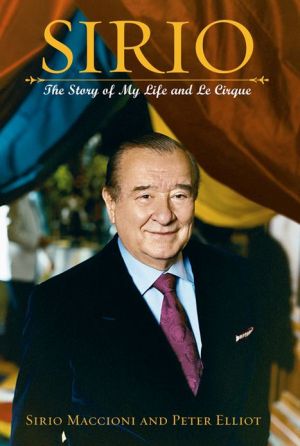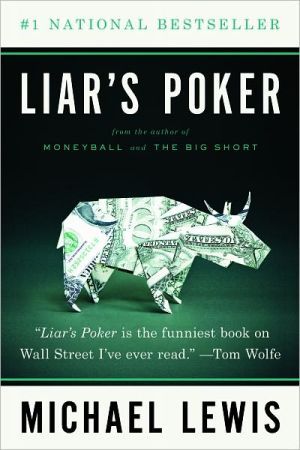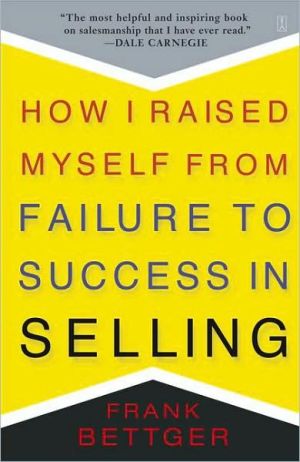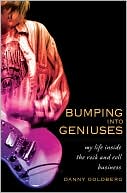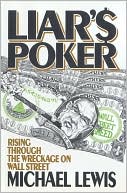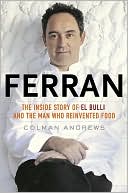Sirio: The Story of My Life and Le Cirque
Sirio Maccioni is a living legend, a restaurateur extraordinaire who has wined and dined high society in New York for nearly half a century. Along the way, he helped launch the careers of many illustrious chefs - David Bouley, Daniel Boulud, and Jacques Torres among them - and befriended a host of celebrities in the arts, politics, and business, from Frank Sinatra and Frank Zappa to Nancy Reagan and Ivana Trump. Now Maccioni lets us into his world, revealing the secrets that have made his Le...
Search in google:
Sirio Maccioni is a living legend, a restaurateur extraordinaire who has wined and dined high society in New York for nearly half a century. Along the way, he helped launch the careers of many illustrious chefs—David Bouley, Daniel Boulud, and Jacques Torres among them—and befriended a host of celebrities in the arts, politics, and business, from Frank Sinatra and Frank Zappa to Nancy Reagan and Ivana Trump. Now Maccioni lets us into his world, revealing the secrets that have made his Le Cirque one of the world’s most celebrated restaurants.With the help of award-winning Bloomberg restaurant critic Peter Elliot, Maccioni recounts the story of his life and his restaurant career. Beginning with his childhood in rural Tuscany during World War II and the tragedies and privations that left him determined to pursue success at the world’s finest restaurants, he shares a journey that took him to post-war Paris and Hamburg and the nightlife of pre-Castro Cuba and finally to New York. By 1961, the dashing young Maccioni had become maitre d’ at New York’s most storied restaurant, the Colony. Within thirteen years, he had the experience and contacts he needed to launch his own restaurant, Le Cirque, which quickly became the hub of café society in New York. From hiring the right chefs and revolutionizing the way top restaurants operate to popularizing now-famous dishes such as pasta primavera and crème brulée, Maccioni reveals how he made Le Cirque such a long-running success—a success that reached new heights when the restaurant moved to a new location in 1997. Along the way, Maccioni explains how he’s dealt with defecting chefs and demanding customers. And through it all, he pays tribute to his proud Tuscan roots and to his wife and their three sons, who operate the family’s other New York restaurant, Osteria del Circo, as well as restaurants in Las Vegas and Mexico City. Like Maccioni himself, Sirio is full of passion, energy, and life—the unforgettable story of the world’s most extraordinary restaurateur. Sirio Maccioni lives in New York City and Montecatini, Italy. Along with his wife, Egidiana, and their three sons, Mario, Marco, and Mauro, he operates Le Cirque 2000 and Osteria del Circo in New York City as well as Le Cirque and Osteria del Circo in Las Vegas and Le Cirque in Mexico City. The New York Times - Adam Platt In putting together this surprisingly readable book, Maccioni and his collaborator, Peter Elliot, have rejected the canned ''as told to'' formula in favor of a more authentic oral-history approach. Elliot's sections are interspersed between passages by Sirio, members of his family, informed food people (Julia Child, Ruth Reichl, Alain Ducasse) and Sirio's myriad celebrity friends. Some of the celebrity quotations are informative; some sound as if they've been composed by press agents in the backs of limousines. But the most effusive, entertaining voice belongs to Sirio himself, who recalls his humble childhood (his mother died when he was young; his father was killed during World War II), his dictatorial training in the kitchens of Paris and his rise to New York dining prominence as the maitre d' hotel at the old cafe society watering hole, the Colony.
ForewordviiPrefaceviiiAcknowledgmentsxiiAngosciaWelcome to Le Cirque2The Maccionis of Montecatini8"Always Tell the Truth"19It's Always About Leaving31Leaving HomeGetting Started in Paris60The Next Generation of Chefs72Hamburg80The Home Lines87Arriving"He's Good, but He's Italian"108From Delmonico's to the Colony119Maitre d'!129Planning a Restaurant149Opening Le Cirque164Restaurant RevolutionaryThe Restaurateur200Kids, Wine, and Creme Brulee210The Ladies and Men of Le Cirque222The Triumph of Simplicity238The Prodigal Son259Losing and Winning270Three-Ring CircusSinatra304Twentieth Anniversary308Osteria del Circo: A Family Restaurant?314The Palace327Le Cirque 2000343New Directions359Don't Play Games with God376Bibliography405Index407
\ From the PublisherSirio Maccioni has lived his life on the periphery of celebrity photographs. As maitre d' and owner of Le Cirque, the New York restaurant where Richard Nixon and Henry Kissinger reconciled, Frank Sinatra parked his limo and the "ladies who lunch" lunched, he has served for three decades as something of a mealtime matador to high society.\ His memoir might have been a shallow name-dropper, full of chat about the Kennedy clan and insights into caviar. But that's the last thing "Sirio" is. Indeed, from the first chapter's anecdote of Ronald Reagan tossing off an ethnic joke, the book signals that it's no gladhanding salute to famous people or monied swells. There is barely another mention of a bold-face name for some 60 pages, but the reader won't mind.\ This is an immigrant's story. In its opening chapters, it keenly evokes a time and place: Italy during the war. "My father was a very good father," the restaurateur writes. "In those days, there was no bad father." In rural Montecatini, first occupied by Germans and then Americans, the author is desperately poor and loses his mother early to pneumonia. What could be bathetic is instead spare and unflinching: He writes of hating the pity of the villagers and of his impatience, at the age of 10, at their empty assurances that his father will recover after a German mortar attack. ("There was no medicine, and no blood," he writes, dismissing the platitudes.)\ With little to eat, Mr. Maccioni knowingly transforms himself into the stock character of war movies: the adorable Italian orphan boy begging for candy from servicemen. "We worked for those chocolates," he notes. He also pays attention as his war-torn city recovers swiftly after the war by marketing itself as a spa for café society. It was a lesson not lost on the young teenager, who was soon making his way in an old-fashioned world of restaurant service, where waiters were timed on how fast they could debone a chicken and the same staff worked breakfast through dinner, taking their breaks in between and sleeping together in a single room.\ Pity the poor tourists in Germany who told the young waiter that, if he were ever in Paris, they had a job for him in their restaurant. He showed up with little French and no money and refused to leave, then traded up to the Plaza-Athenée when he was more fluent. He was still a "skinny, stupid spaghetti boy," he writes, desperate not to return to Montecatini until he could look down on all the people who, he says, had looked down on him.\ As he moved to different hotels, restaurants and continents, he was careful to let the jet-setting clientele spot him (greeting the Onassis clan, for example, in a variety of venues). By midway through the book, Mr. Maccioni is in New York, having deserted his post on a posh cruise ship. He nabs a waiter's job at the prestigious Colony, gets a promotion and then the maitre d's tales begin.\ He tells of the time both agent Swifty Lazar and publisher John Fairchild demanded the same corner table. Mr. Maccioni favored Lazar and was mortified when he found the two were meeting for lunch together. He tells of the pretty women who ate free for decades at Le Cirque, of the politics of sitting Canadian premier Pierre Trudeau nowhere near his wife, and of the betrayal and departure of his best chef, Daniel Boulud.\ Mr. Maccioni is at his most interesting when he tackles the delicate issue of class, of being "a servant, but never servile." It is true that, by his own good fortune and entrepreneurial panache, he joined an elite of sorts by starting his own restaurant and making it thrive. But the book seethes with a class tension that will sting true for everyone who has ever worked among the well-to-do. Repeatedly Mr. Maccioni, maestro to the monied, warns of mistaking client friendships for real ones. He came to know Frank Sinatra, for instance, first at the Colony and then at Le Cirque, going around with him after hours to rival restaurants. But Mr. Maccioni always insisted on calling him "Mr. Sinatra," never "Frank," as the singer wanted. Mr. Maccioni was, he understood, ever the protégé.\ Much, but not all, of this tale comes in the author's own voice, in the form of transcribed interviews done by his co-author, Bloomberg radio restaurant critic Peter Elliot. Elsewhere Mr. Elliot inserts background summaries and, occasionally, blocks of quotations from others, ranging from Rudy Giuliani to Bill Blass. Recipes are at the end of chapters. The baked eggs are excellent, but it's a jarring construction.\ By the end of the book, the tale of the Italian boy who learned cooking in France, served on a German cruise ship and vacationed in pre-Castro Cuba turns out to be an American story. It closes with Le Cirque's expansion to Las Vegas and the controversial relocation of its New York branch from a cozy site on East 65th Street to a noisy space in midtown, garish and circus-themed. The two moves, while good for business, did not keep Le Cirque on the culinary map.\ Indeed, Mr. Maccioni may be a fine chronicler of his time, but he doesn't want to admit that his time may be passing. At recent Le Cirque parties, the paparazzi were snapping Arlene Dahl and Joan Collins, not the bright stars and starlets who once packed its bar stools. Mr. Maccioni, who is brutally honest about what it took him to get to the top—including romancing some of his more powerful guests—needs to be more honest about the difficult fight to stay there.\ He has recently announced that Le Cirque will move back to Manhattan's Upper East Side. Perhaps this last reinvention will return the restaurant to its grandest days. If not, this book is a fine snapshot of them, and of much more. (The Wall Street Journal, August 18, 2004)\ "...autobiography of the inventive gastronome who did much to insert Italian cooking into the world of haute cuisines in New York...a kind of oral history more integrated than the usual as-told-to-approach." (The New York, July 18, 2004)\ Possibly, one day, there will be another restaurant in New York City (or London, for that matter or Rome or even Paris) that packs as much glitter, social striving and jet-set cachet under one roof as Le Cirque in its prime, although one tends to doubt it. The former Canadian prime minister, Brian Mulroney, collected his mail at the restaurant, and Roy Cohn dined there so often that the kitchen famously gave him his own private jar of mayonnaise. On any given night between, say, the first Reagan inauguration and the end of the Giuliani era, the rooms at Le Cirque—and its Ornate successor, Le Cirque 2000—were so saturated with assorted dignitaries, social luminaries and Wall Street fat cats that the owner, Sirio Maccioni, could identify his patrons not just by their dining habits but by the number of bodyguards in their entourage. "Reagan himself had only two," Sirio writes in his engaging new memoir. "Niarchos used to have more than that! And Marcos came with 8 and Somoza with 12!"\ What the corpulent ex-dictator of Nicaragua actually ate isn't recorded here, and it doesn't really matter. Maccioni, who grew up on a farm in Tuscany and worked as a young waiter in some of the great hotels of Europe, is a practiced and inventive gastronome. He was the first restaurateur to introduce simple Italian cooking into the stodgy, Francocentrlc world of haute cuisine. We can all thank Le Cirque for the omnipresence of crème brûlée, and many great chefs (Daniel Boulud and David Bouley. to name just two) have passed through its kitchen. But Maccioni divined, from an early age, that the restaurant business in New York is less about food than about entertainment. In a city hooked on status and power, celebrities are the ultimate entertainment. While celebrities enjoy a good meal (Ronald Perelman prefers his flounder "burnt to perfection," according to Boulud), what they like best is close proximity to other celebrities.\ In putting together this surprisingly readable book, Maccioni and his collaborator, Peter Elliot, have rejected the canned "as told to'" formula in favor of a more authentic oral-history approach. Elliot's sections are interspersed between passages by Sirio, members of his family, informed food people (Julia Child, Ruth Reichl, Alain Ducasse) and Sirio's myriad celebrity friends. Some of the celebrity quotations are informative; some sound as if they've been composed by press agents in the backs of limousines. But the most effusive, entertaining voice belongs to Sirio himself, who recalls his humble childhood (his mother died when he was young; his father was killed during World War II), his dictatorial training in the kitchens of Paris and his rise to New York dining prominence as the maitre d' hôtel at the old café society watering hole, the Colony.\ The secret to flattering very important people, it turns out, is to be charming and professional and not to flatter them at all. Sirio is careful to refer to his many fancy customers as "clients" and never "friends." One of his least favorite words is "presumptuous," as in ''to a Tuscan to be presumptuous is the worst thing you can be." He cuts his teeth as a waiter at the Hotel La Pace, in his hometown, Montecatini, serving grand figures like the Duke and Duchess of Windsor. In Paris, he is befriended by Yves Montand, who gets him a job in the kitchens of the Hotel Plaza-Athenée. By the time Sirio ascends to the Colony, he is fluent in five languages and possesses the innate ability, as Boulud puts it, to "serve the king of Spain and make him feel like he's not the king of Spain." Of course, if you happen not to be the king of Spain, you may be in a little trouble, to which Sirio replies, "What is so wrong with elite?"\ You'd expect a memoir like this one to be filled with shameless name-dropping and, of course, it is. But "Sirio” is also a very fine book about the business of high-end restaurants, and when Maccioni discusses his clients, it is always discreetly within the context of his trade. We learn that Maria Callas could be difficult and Pamela Harriman controlling, and that Elizabeth Taylor and Richard Burton regularly sat down at 2:30 p.m. at the Colony and commenced yelling at each other until dinner. Frank Sinatra develops the habit of critiquing his meals at Sirio's restaurants by writing the words "yes" or "no" on cocktail napkins. When Sirio returns the favor (he writes "no" after Sinatra's friends make fun of President Jimmy Carter's mother), Sinatra refuses to set foot in Le Cirque, and takes his meals in his limousine while his wife eats her lunch inside. And then there's Frank Zappa, whom Sirio momentarily bars from the restaurant because he's not wearing a jacket and tie. Zappa becomes a regular client, and when he’s dying of prostrate cancer, Sirio sends a chef out to Los Angeles to prepare him a last serving of crème brûlée.\ At the height of his powers, Sirio Maccioni comes off as a formidable social force, part Fred Astaire, part Escoffier, part L.B.J. Crème brûlée aside, his great culinary insight was to leaven the tired parade of soufflés and creamy sauces with what he calls "a bistro menu raised to my standards.” To execute this menu, he hired a succession of accomplished and soon-to-be-famous chefs ("cooks," he likes to call them), most notably, Alain Sailhac, Boulud and an enigmatic Cambodian refugee named Sottha Khunn. These days, of course, the cooks are the ones opening the hot new restaurants, and Sirio has announced that Le Cirque 2000 will close in its current form at the end of the year. But wherever you look in the dining world, the Maccioni touch remains. It's in the overpriced bowl of white truffle risotto at your local bistro, and the public's endless appetite for towering, decorative desserts. Sirio was one of the first to fly in seasonal ingredients from around the globe, and it was Sirio who led the great gourmet cattle stampede to Las Vegas. And no matter what the restaurant, if you want a good table on a crowded evening, it still helps to be the king of Spain. —Adam Platt (The New York Times Book Review, July 11, 2004)\ New York’s social history can often be traced through its restaurants. The robber barons adored Delmonico’s, 1950s media darlings fancied the 21 Club and the 1980s’ power elite loved Le Cirque and its dazzling owner, Sirio Maccioni. Maccioni learned his trade in the hotels and restaurants of Europe and New York. By the early 1980s, the dashing Italian was ready to launch his own culinary experiment, and for more than 20 years, Le Cirque on East 65th Street epitomized near-reckless luxury. At first, Le Cirque was known more for the exclusivity of its customers, a blue-ribbon gaggle of celebrities and politicians (many of them, from Nancy Reagan to Frank Zappa, befriending Maccioni) than for the food. But Maccioni’s aggressive spending and the free rein he gave his chefs soon resulted in a dining revolution. The restaurant served as the training ground for chefs like Daniel Boulud, and it claims to have invested Pasta Primavera. Maccioni’s memoir is mostly a stream of reminiscences, with a dash of loving quotes from celebrities. It’s a doting portrait of, in the words of Ruth Reichl, “the most important restaurateur of the era.” Agent, Mort Janklow. (June)\ Forecast : Like Everyone Comes to Elaine’s (Forecasts, Jan. 5) this book is a sure to generate some New York media coverage (it’s already been excerpted in Vanity Fair) and could be popular among New Yorkers interested in the city’s social scenes. (Publishers Weekly, May 24, 2004)\ Daniel Boulud and Sirio Maccioni had a bitter breakup thirteen years ago, when Boulud left Le Cirque. But last Monday afternoon, Boulud reluctantly agreed to attend a lunch at Le Cirque in honor of Maccioni and Peter Elliot’s book, Sirio: The Story of My Life and Le Cirque. (In the book Maccioni complains, "The last years, Daniel wasn't cooking, he was just handing out business cards.”) "Daniel and I talked about business a lot and the future, which may bring a big surprise for everyone,” says Maccioni, hinting that they may form another partnership. Restaurant sources also say Boulud is opening a new restaurant in an old bank on the Upper West Side, but Boulud declined to comment… (New York Magazine, May 24, 2004)\ IF too many cooks spoil the broth, you wouldn't have wanted to slurp the soup at the luncheon Sirio Maccioni hosted at Le Cirque for all the chefs who have cooked at his restaurant over the years and are featured in his new book, "Sirio: The Story of My Life and Le Cirque." Former employees Daniel Boulud, Geoffrey Zakarian, Alain Sailhac, Michael Lomonaco and Jacques Torres were there the other day while Andre Soltner and Alain Ducasse came along to lend support. The chefs left lunch with aprons bearing the legend, "I Survived Sirio." (The New York Post, May 16, 2004)\ WHEN SIRIO MACCIONI kicks off his autobiography, written with Peter Elliot, the party won't be half measure. Sirio is turning Le Cirque over to a June 15 gala with every great chef and restaurant owner in New York invited, along with all those who've been overand under-tipping for 30 years - Marella Agnelh, Oscar de la Renta, Henry Kissinger, Anne Bass, Rudy Giuliam, Mario Cuomo, William O'Shaugnessy, Alain Ducasse, Ron Perelman, Donald Trump, Ivana Trump, Reinaldo and Carolma Herrera, Lally Weymouthand that's only the tip of the iceberg! They'll eat Sirio's caviar in the Red Room, the Blue Room, the Library, the big room upstairs; it will be an invasion of the chic and the undead. Sirio's "The Story of My Life and Le Cirque" contains aphorisms and life lessons: "Right or wrong, when you stand by someone, you stand by them always. You don't always have to like them. If you supported them when they were strong, you support them when they are weak." Hmmm . . . does this apply to one's feelings about the elected president? Just asking. (New York Post / Liz Smith column, May 14, 2004)\ \ \ \ \ \ Adam PlattIn putting together this surprisingly readable book, Maccioni and his collaborator, Peter Elliot, have rejected the canned ''as told to'' formula in favor of a more authentic oral-history approach. Elliot's sections are interspersed between passages by Sirio, members of his family, informed food people (Julia Child, Ruth Reichl, Alain Ducasse) and Sirio's myriad celebrity friends. Some of the celebrity quotations are informative; some sound as if they've been composed by press agents in the backs of limousines. But the most effusive, entertaining voice belongs to Sirio himself, who recalls his humble childhood (his mother died when he was young; his father was killed during World War II), his dictatorial training in the kitchens of Paris and his rise to New York dining prominence as the maitre d' hotel at the old cafe society watering hole, the Colony. \ — The New York Times\ \ \ Publishers WeeklyNew York's social history can often be traced through its restaurants. The robber barons adored Delmonico's, 1950s media darlings fancied the 21 Club and the 1980s' power elite loved Le Cirque and its dazzling owner, Sirio Maccioni. Maccioni learned his trade in the hotels and restaurants of Europe and New York. By the early 1970s, the dashing Italian was ready to launch his own culinary experiment, and for more than 20 years, Le Cirque on East 65th Street epitomized near-reckless luxury. At first, Le Cirque was known more for the exclusivity of its customers, a blue-ribbon gaggle of celebrities and politicians (many of them, from Nancy Reagan to Frank Zappa, befriending Maccioni) than for the food. But Maccioni's aggressive spending and the free rein he gave his chefs soon resulted in a dining revolution. The restaurant served as the training ground for chefs like Daniel Boulud, and it claims to have invented Pasta Primavera. Maccioni's memoir is mostly a stream of reminiscences, with a dash of loving quotes from celebrities. It's a doting portrait of, in the words of Ruth Reichl, "the most important restaurateur of the era." Agent, Mort Janklow. (June) Forecast: Like Everyone Comes to Elaine's (Forecasts, Jan. 5), this book is sure to generate some New York media coverage (it's already been excerpted in Vanity Fair) and could be popular among New Yorkers interested in the city's social scenes. Copyright 2004 Reed Business Information.\ \ \ \ \ Library JournalFrom war-torn Tuscany in the 1940s to post-9/11 New York City, dining legend Maccioni has worked hard to create his place in the world. In Italy, Paris, and, finally, New York, he trained as a waiter and maetre d'e learning to create exceptional dining experiences for customers. His ambition, however, was to bring a more Italian flavor-from ingredients to style-into New York's restaurant scene, which at the time was dominated by French haute cuisine. In 1974, he achieved his ambition by opening Le Cirque; 30 years later, Le Cirque 2000 (a new name for a new location and new century) is going strong, although Maccioni will again be relocating at the end of this year; he has restaurants in Las Vegas and Mexico City as well. Here, Maccioni does for restaurateurs what Jacques Pepin did for chefs in his insightful memoir, The Apprentice, with chapters featuring remembrances by Maccioni and exposition by co-writer Elliot, host of the radio program The Bloomberg Executive Dining Guide. Nicely complementing these narrative portions are interpolated quotes from family, colleagues, and famous clientele. Recommended for larger public libraries and restaurant management collections. (Recipes not seen.)-Andrea R. Dietze, Orange Cty. P.L., Santa Ana, CA Copyright 2004 Reed Business Information.\ \
